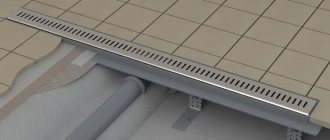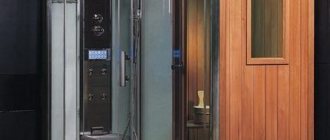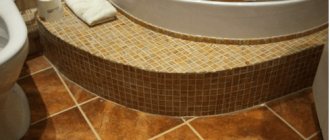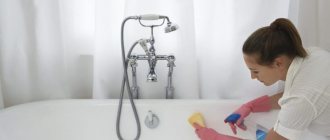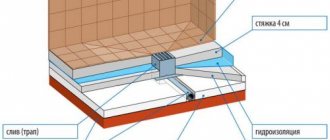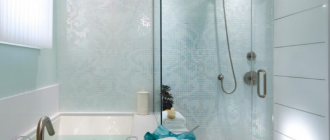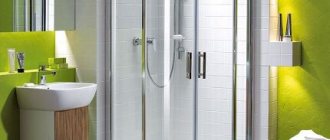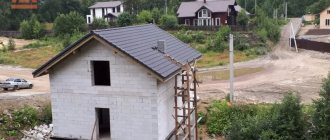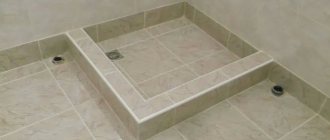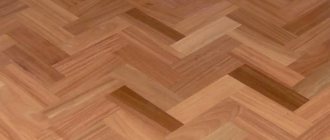How to choose Shower drains and trays
An important part of a modern shower cabin is a system that ensures that used dirty water is drained into the sewer system. For this purpose, ladders are used - drain elements that are mounted in the floor or walls of the booths. More often the ladder is installed in the floor. This is done so that the upper surface of its grate is flush with the floor tiles.
The shower drain is a gutter-type drain system. It is embedded in the floor screed, ensuring free drainage of dirty water from the shower stall into the sewer system. A properly installed system, in addition to draining water, also collects debris, preventing it from clogging the drain channels, and protects the bathroom from unpleasant odors from the sewer.
For bathrooms, drains of different models are used, which differ significantly in appearance. However, they all work on a similar principle, therefore they consist of the same components.
The ladder structure consists of the following elements:
- siphon or dry seal;
- funnel-shaped receiving body;
- outlet pipe;
- mesh protective filter;
- decorative overlay;
- pipelines and couplings.
Shower cabins with drains take up minimal space, are easy to clean and durable. The drain ladder protects the bathroom from emergency flooding.
What is a shower drain?
Shower drains (shower drains, drain drains) are a plumbing device that provides collection of waste water in shower stalls (showers) and drainage of water into the sewer system. In addition, the drain ladder performs a number of special tasks.
In addition to draining water from a tray or from a shower without a tray, the design of the shower drain allows you to perform important additional tasks:
- Blocks the penetration of odors from the sewer into the apartment. The drain device forms a water plug that blocks sewer evaporation without mechanical valves.
- Inspection (cleaning) of sewerage. The shower drain can be easily disassembled and, if necessary, can serve as an excellent inspection hatch for cleaning the sewer.
- Filtration of waste water. The design of the drain allows you to retain large debris and prevent it from entering the apartment sewer.
In addition, additional devices are added to the design of some ladders, and the functionality of the ladder is further expanded. For example, a check valve is installed on the drain pipe of the drain, which serves as a reliable damper for sewer water when the sewer is clogged.
How to make a water seal with your own hands
To install a water seal for a sewer yourself, you do not need special training or expensive tools.
It is enough to be careful and think through every action. They start by shutting off the water at the point of repair, then remove the old device, close the sewer socket and clean the contact areas where the new equipment will be installed from contamination.
If you are replacing a cast iron siphon, you should not waste time trying to unscrew the fasteners. Rust destroys the threads of bolts and nuts, so it is easier to break the old device with a hammer, after wrapping it with a thick rag so that the fragments do not fly around.
The size of the outlet pipe of the new device must correspond to the diameter of the sewer pipe. The installation sequence of siphons may differ depending on the installation location and design features of the device. But the general rules apply to all cases, including installing a water seal in a bathhouse with your own hands.
A grate is inserted into the drain of the plumbing fixture from above, and a gasket is placed under it. Using a long screw, fasten the grille to the connecting pipe at the bottom of the bowl.
A siphon is attached to the pipe using a nut, placing a rubber gasket between them. Before tightening the nuts, adjust the height of the device. The outlet pipe is inserted into the socket of the sewer hole. An O-ring may be needed to seal this joint. The quality of the installation is checked by passing water through a siphon for several minutes.
I like it I don't like it
Shower drain design
To further analyze the types of drains for shower cabins, let’s remember its general design.
As you can see in the photo, the design of the ladder consists of:
- Housing (plastic);
- Siphon (for sediment sediment);
- Discharge pipe (there are two similar pipes in the passageways);
- The shutter is an air damper against odors;
- Pressure flange;
- Decorative drain grate.
Device
Drainage systems using drains are needed for manufacturing enterprises, chemical and biological laboratories. They are used in public swimming pools, childcare facilities, student and institutional dormitories and so on. As practice shows, shower devices using a drain are much more economical than a classic cage. The size of such a cabin is selected personally, taking into account every need and available space. The main part of the product is the funnel that receives water.
It acts as an external circuit, drains and removes water. The flange block must ensure that the retaining water of the membrane is sealed. The siphon block, together with the removable lattice structure, is built inside. It prevents large-scale clogging. Hydraulic seals prevent the smell of gases from spreading throughout buildings. There are structures equipped with mechanical (working without liquid) vestibules.
The very bottom of the housing is occupied by the outlet and coupling. Using it, you can connect the device to a sewer pipe. Additionally, the sewer drain includes pressing and sealing parts
It is very important that the device is completely sealed; this parameter must be assessed before purchase. It is required to use pipes and couplings of the same diameter only
Mandatory requirements in residential premises are:
- protection against odors;
- adjusting the depth of the ladders to the floor level;
- second productivity from 1.2 l;
- sealing elements;
- The cross-section for a drain running vertically is 11 cm; horizontally, 5 cm is enough.
The gratings should be installed at the same level as the floor covering. It is not allowed to prepare tile joints over 2 mm; grouting with a moisture-resistant material is required. The outlet pipes are installed at an angle of approximately 0.1% relative to the length. The screed must be removed when installing drain funnels. No less important is the sealing of each connection and joint, waterproofing and thermal insulation.
The thermal barrier is installed around the plumbing drains. The stretch is created by continuously monitoring the inclination of the pipes. When the installation is completed, the raw concrete is leveled and tiles are laid on it. Since the floor covering, thanks to the ladder, is on the same level with the surface of other rooms. Despite the labor intensity, almost everyone can do such work without the involvement of additional assistants.
In order for water flows to move in the direction of the ladder, it is necessary to ensure that the floor is tilted in the desired direction by at least 150 mm. Expanded polystyrene is placed below, the layer of which occupies 40-50 mm. This material ensures that noise is contained and heat loss is stopped. Then a rough screed is made, for which another 4-5 cm of concrete is used. Above it is an impermeable membrane, which is made from a floating waterproofing material.
Next, a slope-forming screed is placed. Ceramic tiles are laid above it. The optimal level of waterproofing is ensured only when facing walls after laying, and not vice versa. The lattice product should be deeper than the tiles. Before attaching all parts, be sure to calculate the thickness of any floor layer.
Consumer parameters for choosing a drain
If you google the query “shower drain”, you will see a wide variety of types and types of this device. What to be guided by when choosing it?
Ladder height. Each shower drain has a technical height parameter, which indicates how much the shower floor level should be raised from the subfloor. In the photo you see that the heights of the drains are different and their choice should be tied to the shower project.
types of drains for shower cabins by base design
types of drains for shower cabins by height
Number of pins. Usually the drain has one sewer outlet. This assumes that the shower stall will be installed last in a row of plumbing household appliances. If this is not the case, and there will be a sink behind the shower, then you need to choose a drain with two pipe outlets.
Additional devices. If you have low sides in the shower or the shower is built into the floor without a tray, it is better to choose a drain with a non-return valve; it will protect against backflow of the sewer when it is clogged.
Lattice decor. The last parameter in choosing a drain is the appearance of the grate. The choice here is huge, but it does not affect the operation of the ladder. Although it is worth noting that the very fine grille requires frequent cleaning.
Floor and drainage
Laying a sewer line is much more hassle than directly draining a bathhouse, but it is better to do it, the more carefully, the better.
Even if the floor in the bathhouse is covered with wooden gratings, it is still better to make a screed along the beacons with a slight uniform slope towards the ladder , and lay tiles on it. The final cutting of the drain extension can be done when it is known exactly at what height the tiles will approach the drain point. If the work is done very carefully, then even with a minimal slope there will be no puddles.
Providing access, with the ability to replace all elements, is too much of a luxury for an ordinary bathhouse. Therefore, you should not avoid work that may seem unnecessary, for example, the depth of laying the sewer system should not be less than the freezing depth . Insulating the floor under the screed with a 20 cm layer of expanded clay with a rich cement mortar is by no means an excess. A dry ladder is also not a panacea - dirt that gets into the shutter can prevent it from closing tightly. At the end of the season, it doesn’t hurt to wash the removable elements. Buying a dry water seal in a store or making it yourself - this question is not necessarily related to financial difficulties.
Two types of shower drains
Some sellers distinguish between two types of shower drains. They carry out this division according to the design of the ladder:
1. The first type is a standard ladder. It is quite compact, shaped like a barrel or box. The drain hole of such a drain is small, round, less often square.
Standard shower drain
2. The second type of drain is called a shower tray. It lives up to its name. This device has a clear length, is shaped like a rectangular tray with a beautiful decorative lid.
Two shower drains and one shower tray
There are two types of ladders, in addition to their appearance:
- Installation method (there is a frame on legs);
- Increased lifting height (the siphon of the tray is much larger);
- Drain capacity. For trays it is much higher.
- Price. Shower trays (linear drains) are fundamentally more expensive (prices below).
Removing blockages in the sewer system
Most often, the cause of siphon failure is an ordinary sewer blockage. To remove it, you can use a plunger or chemicals.
If this does not help, you need to clean the siphon itself. It is disassembled and cleaned using household chemicals.
It is also good to disinfect the inside.
If this did not work or helped only slightly, it is necessary to clean the drain pipe. To do this you will need a plumbing cable.
This is done in this order:
- it is necessary to unscrew the nut that connects the siphon to the drain hole;
- unscrew the joint between the siphon and the sewer pipe;
- Substituting the container, remove the water seal;
- insert the cable into the drain pipe, go all the way when you feel resistance;
- Using rotating movements, clean the clogged area.
If the pipe has many turns and zigzags, cleaning is done through a special window. In this case, it is necessary to unscrew the plug, first replacing the bucket; insert the cable and push it all the way; Rotate the handle until the blockage is removed.
Advice!
After you have cleaned the drain, you need to rinse it with hot water for several minutes.
From the history of shower drains
There is no need to think that shower drains and trays are a new invention of mankind. In fact, drains came to the attention of the public and appeared in stores with the fashion for showers in apartments and houses. Previously, drains and shower trays were talked about only in the mention of public showers in swimming pools, bathhouses, and showers at work.
No need to think. That these ladders have gone into oblivion. They are actively used only not in apartments. Although I am sure that in dormitories and communal apartments, similar drains may remain in the showers.
Variety of design solutions
Today on sale you can find many dry ladders that have their own unique configuration. There are three main types of drains, depending on the shape:
- corner;
- round;
- rectangular.
Corner drains are mounted in a corner (hence the name) and are almost invisible. Rectangular and round fixtures can be installed in any part of the bathroom. Plastic, steel and combined models are very popular in the plumbing market.
Gratings for drains differ in the pattern of slots, perforations, etc. The range of gratings is incredibly wide. There are also products that have LED backlighting. A backlit drain can create a unique atmosphere in the bathroom. However, the cost of such a device is higher.
Depending on the design, the drain is installed in the center of the floor or in any corner, and the grate can play a decorative role, complementing the interior
There are also quite a lot of budget options, so choosing the right option for a specific case will not be difficult. It is worth remembering that the appearance of the device is secondary. The main thing you need to pay attention to when choosing such a device is the technical characteristics. This will allow you to purchase an effective product that will last for many years.
Shutter design
The drain seal prevents sewer odors from entering the room. The following types of valves are distinguished:
Hydraulic valves. They work only in a heated room, but without heated floors. The smell is covered by the remaining water in the drain. Does not work if the shower is not used for a long time.
Note: On the market you can find drains with a “dry water seal” (Inoksprom Plant). They cover odors in both dry and undrained systems.
Mechanical shutter. For showers without heating and showers that are frequently used. The ladder has a rotating lever that needs to be closed when not in use for a long time.
Check valve shutter (universal). I mentioned it; a check valve is installed on the drain pipe. It blocks odors and sewer water in the event of an accident.
Dry shutter. Blocks odors with mechanical barriers; water does not participate in the barrier. When the shower is not in use, the shutter is closed and prevents odors from entering the room. When using the shower, the water opens the damper. Based on the type of valve, the following dry valves are distinguished:
- Membrane. The membrane contracts as water passes through and returns to its shape after using a shower.
- Pendulum. The water drains, the pendulum opens the drain, the water stops flowing, the pendulum closes the drain.
- Float. The membrane operates like a float.
Drains with a dry seal should be chosen for showers that are rarely used. If the shower is used every day, without long breaks, then you can choose a drain with a hydraulic shutter (it is cheaper). If you do not use the hydraulic valve for a long time, the water in the drain evaporates and an unpleasant sewer smell comes from the shower. Such drains are plugged with a rag when not in use for a long time.
Reasons for water seal failure
Often in bathhouses connected to a central sewer, an unpleasant phenomenon occurs such as squeezing out the water seal. The liquid from the water seal can either be squeezed out into the steam room or washing room, or discharged into the sewer pipe.
In both cases, the reason for the release of the water seal is the lack of ventilation of the sewer lines. Excessive pressure inside the pipes squeezes out the contents, and if a large amount of water is discharged into the sewer near the drain point, the water seal, especially the transom seal, can easily be left without liquid in the bellows.
Installation method
The last parameter that distinguishes the types of shower drains is the installation method. Here are the differences:
- Point ladder. It is located anywhere in the shower, usually closer to the middle. Requires multi-plane slope.
- Wall-mounted (usually a tray). The design is more suitable for installation against a shower wall. Requires sloping of entire shower floor.
- Angular. Shower in the corner. Requires a conical floor slope.
- Built-in slot. Mounted into the wall, a gap is made in the wall for drainage. Features powerful water drainage. Requires slope and complex installation.
- Ladder in the wall
For information, I made a screenshot of real prices for shower drains:
Water drainage standards
There are standards for draining water from the SanPiN air conditioner that prohibit the drainage of condensate to the street. It is recommended to discharge condensate directly into the sewer system. In this way, you can avoid unwanted consequences from moisture settling on the air conditioner evaporator.
It is highly not recommended to remove moisture into the stormwater system. The reason lies in the unstable operation of the storm drain. When there is heavy rain, high pressure builds up there. Water can easily rise through the drainage pipes and damage the air conditioner, flooding the living space
The frequency of maintenance of the air conditioner drainage depends on the correct installation of the condensate drainage system. Use more expensive tubing that does not change internal shape when bent. This way you can build a reliable system with unhindered movement of condensate to the outlet.
conclusions
Little in plumbing is done just like that. A large selection of drains is determined by the features of installation and use of shower cabins. Types of drains for shower cabins are selected primarily according to the features of installation and use.
- If the shower is rarely used or the bathroom has a heated floor, then you need to choose a drain with a dry seal or check valve;
- If you have low sides of the shower or a shower in the floor, then you need a drain with a check valve;
- If the shower will be used in heavy duty mode, then it is better to choose a shower tray (linear drain);
- If you have problems with the sewage level, then you need to think about a drain with a drainage pump (about them in the next article).
Installation
Shower drain Viega Advantix 452452 100×100 mm dry shutter. Photo by Leroy Merlin
A dry shutter can be part of various designs; if you follow the instructions and carry out the work carefully, their installation will not cause difficulties . Instructions are supplied with the plumbing kits. The biggest problems when doing DIY installation are caused by high-quality sealing . Therefore, if the performer is not confident in his own abilities, then it is recommended to turn to specialists. But installation is quite simple, the main steps are:
* you need to check the device ; the sealing elements must be exactly in place;
* between the siphon and the plumbing fixture it is necessary to place an o-ring , which seals the joint;
* installation of a siphon and application of sealant to the joints.
